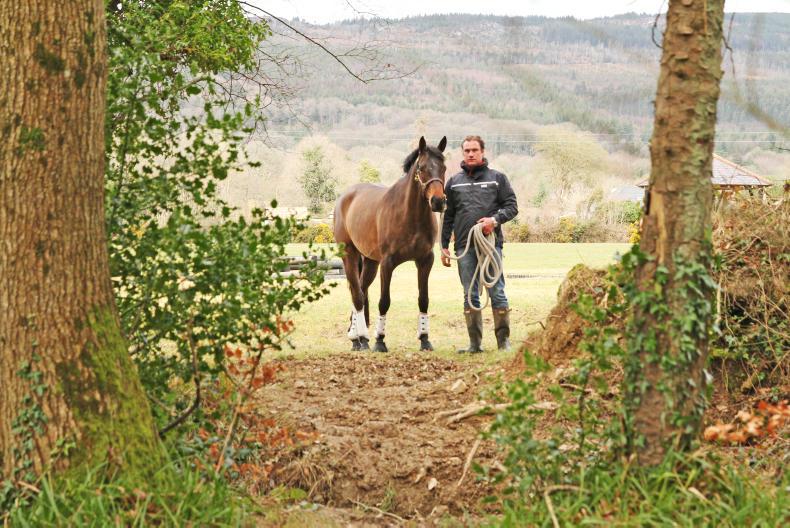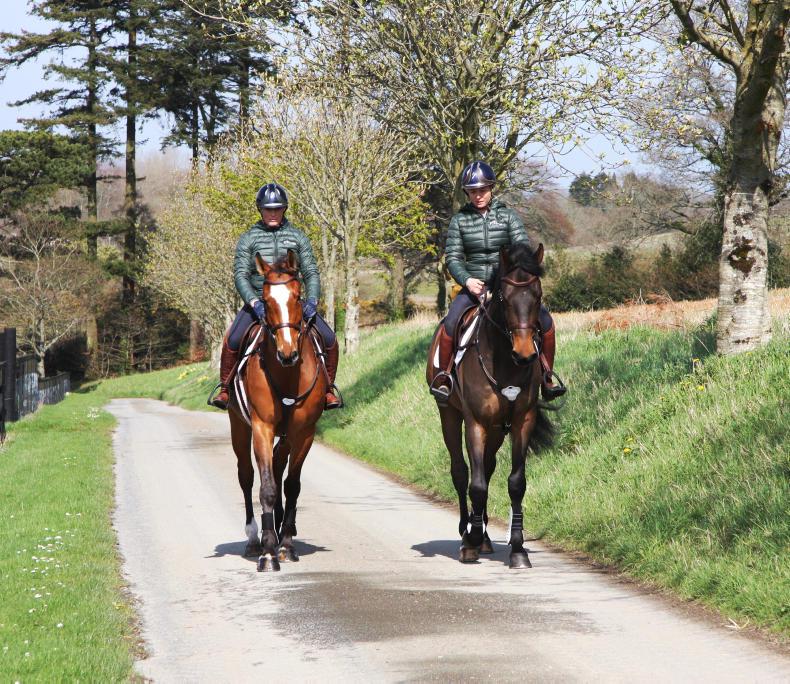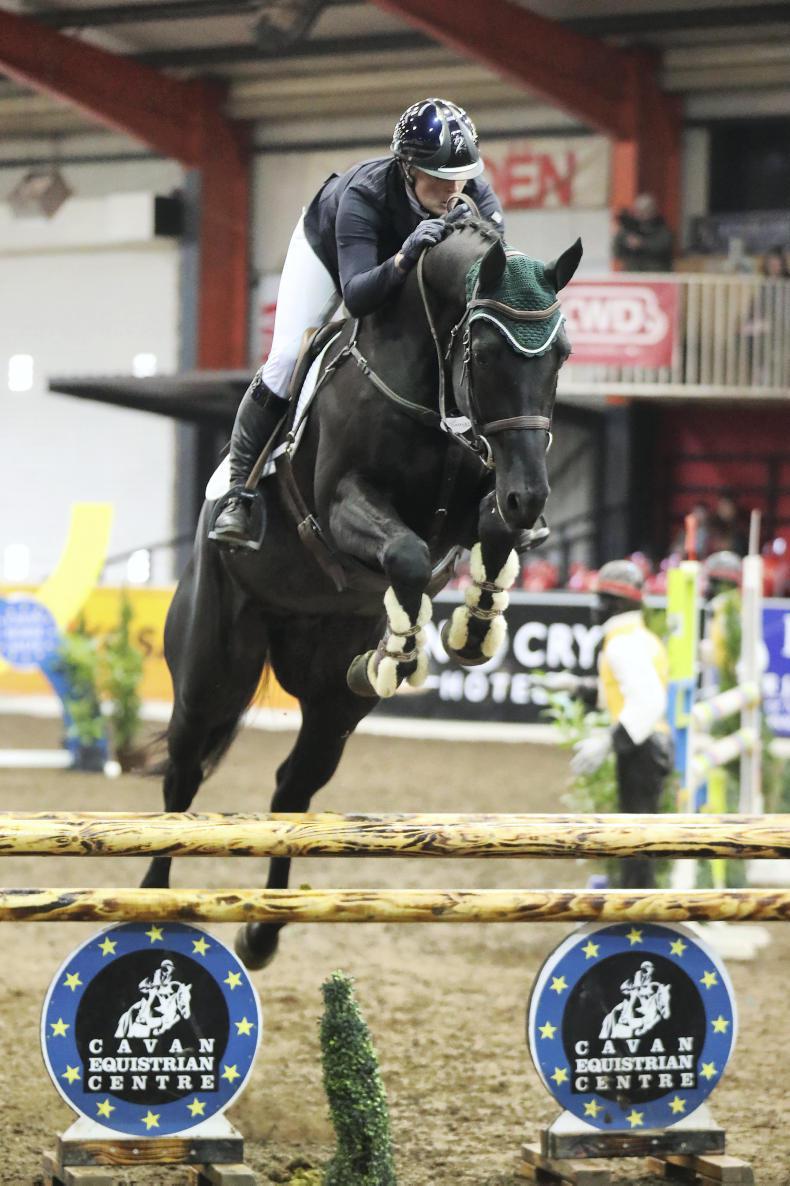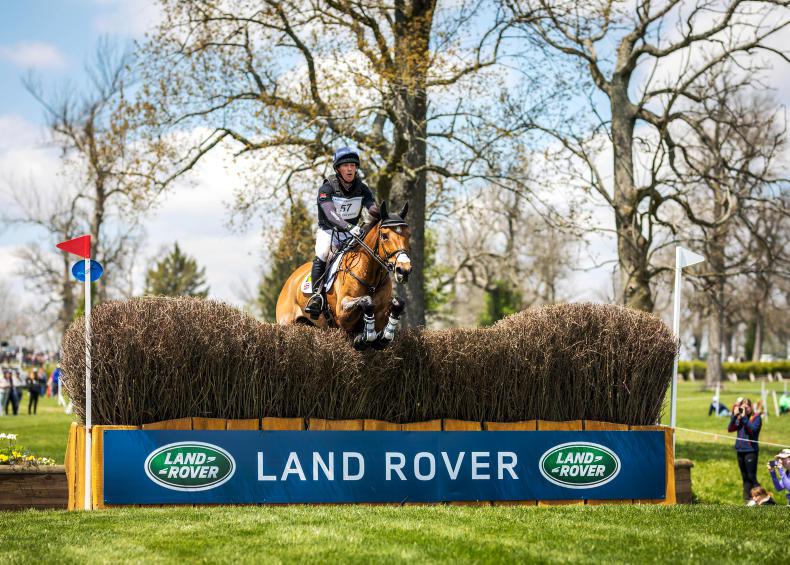WHEN Richard Sheane burst onto the dealing scene a decade ago, few would have would have predicted that his rise through the ranks would have been quite so meteoric.
Together with his wife Georgina, Sheane created the now phenomenally successful Cooley brand, one of the most recognised prefixes in the equestrian world
At the last count, there are just short of 200 Cooley horses registered with British Eventing alone, while almost as impressive, there are over 100 Cooley prefixed event horses currently running under USET (American eventing) rules. Among them are some of the sport’s most famous names, including Olympian Cooley Rorkes Drift and last year’s Blenheim winner Cooley Cross Border. Further representatives shine in other spheres, including the show jumpers Cooley In Time and Cooley Jump The Q.
As a result, the couple now count many of the world’s best riders as customers and friends, and somewhat more unusually their client base also features show business personalities Stormy Daniels and British comedienne Jennifer Saunders.
Richard Sheane is a native of Co Wicklow and grew up only four miles from where he now resides. His early equestrian life was spent learning the business, and following a spell in Switzerland, and time with show jumper Edward Doyle, Sheane set out as an agent. He became a familiar figure at the events and shows, constantly spotting, filming and sourcing horses for an increasingly quality list of clients.
A major turning point was his marriage to Georgina Philips, whose late father Tim was a prominent eventing force. The family also hosted a popular horse trials fixture at their home at Ballinacoola, which in later years, achieved international status.
“My father always decided that I was going to marry Richard Sheane – who was completely unsuitable!” jested Georgina. “He absolutely adored Richard, and he turned out to be right.”

Like her father, Georgina is no slouch when it comes to business, and when the couple began to sell their own stock, it was she who persuaded Richard to trade under a prefix.
“It certainly wasn’t my doing,” explained Sheane. “I was dead against it at first but Georgie felt that we needed to put our money where our mouth was. Once we had made the decision, we both agreed that it needed to be a name that was easy to pronounce in any language, People struggle to say some of the more Irish names so, as my home farm is Coolnakilly, and here is Ballinacoola we settled on Cooley, and reflecting now, I have to say that I’m so glad we did it.”
The couple set up their base at Georgina’s home in Glenealy and while they sold a few event horses, their initial trade was based around the hunter market. Through this, they met event contacts in the UK and, wanting to take the business a step further, they made the decision to expand to America. “We literally decided to pack our bags,” Georgina said.
The couple had during the year sold a horse to Bernadette Halpern and Jim Cogdell from The Fork Equestrian Centre, and through them, made their opening contacts.
Picking up the story, Richard continued, “Jim in particular went out of his way to introduce us to people, and told me afterwards, that he had bought many horses in Ireland over the years, and I was the first person to ring him after the horse arrived to make sure all was well. That was a lucky phone call because every person we met, he told them the story! That certainly got us going in America.”
This turned out to be the first of many trips across the Atlantic, as the couple soon realised that the Americans in particular like to meet the people they planned to do business with. This is in contrast to the English or European client, who are often just as happy to make the phone call. “But to be fair, the Americans have a longer trip to make – and it’s a bigger investment,” explained Sheane. “Now it’s slightly different because we go on recommendation.”
Recommendation and repeat sales are the crux of the Cooley ethos. “We have never had to advertise a horse and I have no intention of doing so,” said Richard. “The whole business is based on word of mouth, and in that way, I think you get a better quality of client. You can build up relationships and gain repeat business.”
While social media has become an important marketing tool for many, it is not a medium that the Sheanes particularly favour. “I think it’s a very mixed blessing,” said Richard. “This advertising horses is all very well on Facebook but I don’t know that I think it’s a good business model. We prefer to let our horses do the talking.”
TOP OF THE SPORT
Of course Sheane has been lucky to sell many of his horses to good riders and as a result, the Cooley horses have ricocheted to the top of the sport. “I remember the Dutch dealer Paul Hendrix said to me once, ‘Success in dealing or sport only comes with good riders’ and that is very true. We realised from day one that we needed an Oli (Townend) or Piggy (French) to be sitting on a Cooley horse,” revealed Georgina. “We also knew that at times we would have to sell horses at cost or at a loss, but we were going to do it.”
Staying true to the belief of having good riders and selling to good riders, the Sheanes naturally count stable jockeys Katie O’Sullivan and Beth Burton as integral members of the team. Describing the experienced O’Sullivan as ‘the Michael Jung of producing young horses’, Sheane is fully appreciative of her skill. O’Sullivan competed up to four-star level with her own Shannondale Que, and although she now focuses on the youngstock, Sheane is happy to keep a horse for her to compete through the grades. Last year she produced the country’s top ranked six-year-old AKD Cooley Lockdown, and this season has another exciting prospect in the recent Tyrella winner Je T’aime Cooley. Sheane praises the attitude of both O’Sullivan and the British-born Burton, who have to be prepared to show horses at any time if needs be.

“The two girls are brilliant for our job, and I’m very lucky to employ them. They are very good riders, and they are very good trainers of horses, but most importantly, people are able to ride the horses afterwards.”
Head girl Joanna Barnes is another vital cog in the close-knit team, most of whom have been resident at the Cooley base for several years.
“We’re a small team and we’re kind of mad about each other,” revealed Georgina. “That might sound strange but we really do care, and the groom is as important as Katie. We only want the best for the people who work for us because they have to work so hard. It’s not that Richard is hard to work for, but if the phone goes at four o’clock in the morning and someone wants to see a horse – they will be seeing a horse – and the horse will be turned out to perfection. You have to have that attitude to be successful.”
Sourcing the right type of horse is an ongoing quest, and by far the biggest challenge. Word of mouth probably accounts for the majority, but Sheane also buys direct from the breeders and from the sales.
“Funnily enough I’m getting more and more calls from breeders,” he reflected. “Sometimes I’ll buy a three-year-old then follow it up by looking at the younger half-brother at home.”
Unsurprisingly, Sheane spends a large proportion of his working week on the road, but he also has an astute team of spotters scouting on his behalf. “They are good lads, and lads I can trust,” he added. “Time is precious, and we are not able to stand at the ringsides like we used to. Okay we don’t buy all of them, but if these lads say the horse is nice it usually is.”
There is no doubt the Cooley horses are of a type – eye-catching, elegant athletes with a talented jump.
“I do like a good-looking horse, with a reasonable conformation,” Sheane states. “After that, it has to have a good brain - as that opens a lot more markets. It also has to be an athlete and a really good jumper.”
Contrary to the beliefs of many, Sheane is not an avid follower of thoroughbred blood. “I’m not a blood freak,” he admits. “Ideally 50% or more would be great, but the fact of the matter is that a lot of the good horses I’ve sold don’t have it, and Cooley Rorkes Drift is a prime example. I’d be more worried about them being blood in their mind and way of going than I am in their veins. I think a lot of people get confused. If it’s a cold horse, it doesn’t matter how much blood it has and vice versa. The horse has to be a blood operator.”
PRIORITIES
Movement is another much discussed issue, and like many pundits, Sheane put the walk and the canter among his priorities. “If a horse can’t canter, you’re at nothing,” he said.
Interestingly, the two Cooley horses that have probably produced among the best dressage marks in recent times are horses with workmanlike trots, and horses that today he admits he would have a job to sell.
Importantly however, both Cooley Cross Border and Cooley Rorkes Drift were trainable, and if their trots were not extravagant, they had, according to Sheane, ‘gears within the pace’.
Although Sheane will buy a nice horse from any age, he would primarily favour a four-year-old, followed by a three-year-old, then move up to those aged five or six.
“Some years you can say that the three-year-olds are better than the four, but you can’t beat watching a horse ride around, even if he’s as green as a leek, and there is no doubt that the best horses I have bought have been four-year-olds.”
While the Sheanes obviously want to sell more and more horses, Richard is very aware of keeping the quality high. “I will run out of horses before I run out of clients,” he declared. “I’ll sell around a hundred a year, but in recent times I’ve been light on horses and nearly work harder to increase my contacts to buy than to sell.”
Although Sheane is quick to describe himself as a dealer, he is modest as in reality he is also a producer. He lunges every horse across the country himself and takes great pride in doing so. A shrewd and knowledgeable assessor, he will also watch Katie and Beth school the horses both on the flat and over fences. “I do three things,” he said. “On a typical day without clients, I lunge and school horses with the girls, I go to look for horses and I sell horses.”

Sheane’s ability to spot a horse is summed up by Georgina, who comments simply, “I’m so proud of him. He is a genius. Sometimes he will bring horses home and I will say to him, ‘Richard, what have you bought? He may not do anything else well, but he’s certainly good at this.”
Richard is constantly watching horses, looking at the differing progeny of sires and educating himself at every turn. “You may not buy them all, but it can come in useful when you’re assessing the one you do want to buy,” he explains.
TRACKS AND TRAILS
The picturesque venue at Glenealy is blessed with natural facilities, which most importantly include large areas of woodland. Here there are tracks with small jumps, and lanes, which Sheane cites as a vital tool in their training regime. “We almost spend as much time in the woods as in the school,” he remarked. “This is especially valuable for the former show jumpers who can go splashing through the mud and ditches as they may not have seen many natural obstacles.”
On average, clients will come three or four days a week. The difficult task of organising the diary falls to Georgina, as does dealing with the numerous X-rays which are sent all around the world. While the couple do take videos, they are not a major part of their selling ethos. “We are bad at taking enough of them,” said Georgina. “We now have a reputation, where we can say to people, ‘Come in and see what we have.’ You can send a million videos, but when they come, the horse they like probably won’t be the one they have seen on film. I always say to them – and it’s hard if they are making their first visit – trust us and we will show you good horses. They might not always find the horse they want but at least Richard will know what they are looking for and will call them when he has one to suit.”
The reputation not only of the Cooley brand, but also Ireland as a selling nation is a subject that Sheane is passionate about. “There is one thing that I truly believe in,” adds Sheane. “It makes no difference which vendor in Ireland a horse comes from – if it’s a bad horse, and this largely applies to America, it is just known as coming from Ireland. That’s why it’s so important, because those customers just won’t come back, and it’s all over. I think it’s essential, that whether it’s from me, from a sale or whoever, that the horse that is going out has to do something of what you said he would do. It is very important that if a horse is getting up on a plane to go to America that he is right. It really matters to us that the horse is what we say he is, if he’s not, then we will sort it out. If a horse is sharp, then say it is sharp. You won’t keep everyone happy, but if you try you’re halfway there.”
FUTURE PLANS
Understandably the costs of running such a large and high-profile operation are, according to Georgie, “massive”. Veterinary bills in particular are astronomic, as every horse is fully vetted and X-rayed prior to purchase, and at least one in every four does not work out. “The vets that I use know the market that I’m aiming at, and if they are happy that eight out of 10 vets will pass the horse, then I will buy him. Because if you go for 10 out of 10 you won’t buy any horses,” said Sheane.

Oliver Townend and Cooley Master Class won the 2018 Land Rover Kentucky Three Day Event (Photo: Kentucky Horse Park)
Another significant financial impact, and an emotive one for all connections, is the regular payments to the FEI. Retaining the invaluable Cooley prefix is not cheap, and fees to the FEI can run up to about €60,000 a year.
“Surely we want to encourage commercial brands into the sport,” said Georgina. “If you have a sponsor approach you wanting to buy a horse, then surely it is off putting to open by saying that first we have to charge you a €1,000 a horse. It’s a deterrent.”
The fee is due for the initial FEI passport, and again every four years when the passports are renewed. “The only way forward is for the FEI to take control of the prefixes and charge a one-off fee,” concluded Georgina.
The couple now try to sell the horses with an FEI book because, as Sheane explains, “At least then although it’s a big bill but it is not a surprise bill. One thing I am adamant about however, is that if you buy a Cooley horse, then you own the horse and have every right to take the name off it. We never take the breeder’s name off because the breeders are the most important people to us – no breeders no business. So, if they have a prefix on, I don’t remove it but I can’t stop people down the road doing so.”
Nowadays, the Sheanes own around a hundred horses, easily outnumbering the extent of the stabling at Glenealy. This will change within the next year or so as a new complex is under construction on land across the road.
With plans for several barns, an indoor school and a house, the couple are looking forward to the relocation.
The move to the new yard will crown 10 rewarding years, but where does Sheane see himself in the long-term future?
The couple now have three children, Arthur, Ellie and Hope, and even at a tender age, Arthur shows every sign of following in his father’s footsteps. “I’m very conscious of the fact we are riding on a little bit of a crest of a wave at the moment, and my aim is to maintain that,” reflected Richard.
“We may also have a few more show jumpers than we do now, as this is a market we would really like to break into. We will maintain our reputation and keep up the high standards. I want my kids to be horse dealers, obviously they don’t have to be, but I’d like to think I’m putting a business together that could continue on to the next generation.
“I’m proud of our results and am determined to keep it that way. We’ll let the horses do the talking.”